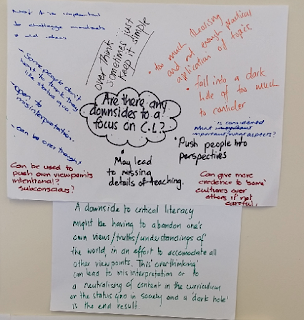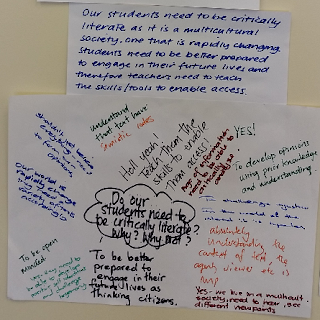Welcome to my Reflections Blog. This blog is a collection of events, resources, activities and reflections of my work as an Educator in Auckland, New Zealand. These posts are my own thoughts and opinions and are not a direct reflection of my employers.
Friday, June 10, 2016
Critical Literacy and Cultural Responsiveness
How can we practice Critical Literacy if we aren't culturally responsive or critical thinkers? How can we be culturally responsive, if we don't reflect on our own cultural consciousness and know how and why we think, feel and act towards others? These are questions I posed to staff when I presented my learning on Critical Literacy and Cultural Responsiveness. Below is the presentation:
The Song of the Bird
This is an insightful video relating to experiential learning. It's old but is still very relevant to this day. Is this the key to unlocking Maori and Pasifika achievement? Should we as educators be providing a more holistic approach with our learners, where the focus is on the Key Competencies and creativity? Thought provoking and interesting...
Critical Approaches to Literacy - Summary
I have come to the end of my first semester back at AU and a highlight for me during this time has been my participation in the Critical Approaches to Literacy paper with Helen Villers. I found this paper inspiring, thought provoking, reflective and insightful. On reflection, I wish I had have blogged about each session I attended during this course (it was a block course, so the learning was over 3 Saturdays and four days of the April holidays). While there was so much to ingest throughout the sessions I have attempted here to give an overview of the learning in brief in the notes I kept through the duration:
Multimulti everything -
Multimulti everything -
- Multi media,
- Multi culturalism,
- Multi disciplines,
- Multi literacies
- Professor Steven May - Making multi cultural education work
- Brian Bulevant - the pluralist theory
- Elwyn Richardson - the song of the bird
- Sylvia Ashton-Warner - Grounded theory in literacy development
- Murial Simpson - championed the first ready to read system
- Barbara Comber
- Pualo Freire - Social justice
- Clarke & Whitney - Deconstructing, Reconstructing text
- Michael Haliday - Linguist
- Delpit (1988) - The Culture of power
- James Paul Gee - big D discourse and little D discourse. Discourse is bigger than the language but a way of being. Little D is the everyday language.
- Jim Cummings - BICS and CALPS
- Helen Timperley - Adaptive expertise through continuous inquiry and being able to adapt practice to meet the needs of students.
Elwyn Richardson – Song of the bird. Example of “Do it, Say it, Write it, Read it.”
Radical Change Texts:
- Researchers - Eliza Dresang and Sylvia Panteleo
- Accessibility, connectivity and interactivity - books that compete with digital text and push boundaries of sensitive subjects (death, childbirth, decency…)
- Be careful and clever about who the text is chosen for…
 Authors of RCTs - Shaun Tan, John Marsden, Emily Gravett, David Wiesner, Herve Tullet (Press), Istvan Banyai (Zoom), Jenny Baker (WIndow, Belonging)Emily Gravett – Wolves. Pre lesson: Factual Hand/Literary Hand (Great inter-text book)Wolves change rivers (You tube video) links well to this book.Follow up with ‘The Wolf Story’Wolves by Emily Gravett - breaking it up by introducing the cover, making predictions, making connections with what we knew about wolves, making connections between texts etc...Gradual Release Model: To - With - By (Balanced Literacy Programme)
Authors of RCTs - Shaun Tan, John Marsden, Emily Gravett, David Wiesner, Herve Tullet (Press), Istvan Banyai (Zoom), Jenny Baker (WIndow, Belonging)Emily Gravett – Wolves. Pre lesson: Factual Hand/Literary Hand (Great inter-text book)Wolves change rivers (You tube video) links well to this book.Follow up with ‘The Wolf Story’Wolves by Emily Gravett - breaking it up by introducing the cover, making predictions, making connections with what we knew about wolves, making connections between texts etc...Gradual Release Model: To - With - By (Balanced Literacy Programme)
- Between paired reading and inquiry there should be SSR
- At the beginning point the student will be totally reliant on the teacher...at the end point student will have full independence.
- Modelled writing is based on ‘Think alouds’.
- Guided reading and Guided Writing is the heart of the Model (Zone of proximity)
- Everyday in everyway there should be a balance of oral, written and visual.
- Fine balance between levels of activity and passivity
- Aesthetic opportunities should be available on a daily basis - Sir Ken Robertson
- Multimodal - aural, visual, spatial, gestural, written, kinesthetic, LinguisticTowards the end of the semester, we were facilitated through a bus stop activity where we had a minute to write out thoughts about questions posed on A3 papers, passed around the tables...These are in no particular order:
ARE THERE ANY DOWNSIDES TO A FOCUS ON CRITICAL LITERACY?
HOW DO PEOPLE'S IDEOLOGIES IMPACT ON US?
HOW WOULD YOU DEFINE CRITICAL LITERACY?
WHAT IS THE DIFFERENCE BETWEEN CRITICAL LITERACY AND CRITICAL THINKING?
DOES IDENTITY COUNT? IS THIS CRITICAL LITERACY? WHY?
IS THERE A LINK BETWEEN CRITICAL LITERACY AND NATIONHOOD? HOW SO?
WHAT IS YOUR UNDERSTANDING OF HEGEMONY?
DO OUR STUDENTS NEED TO BE CRITICALLY LITERATE? WHY? WHY NOT?
WHY MIGHT YOUR COLLEAGUES THINK CRITICAL LITERACY IS NOT IMPORTANT?
HOW MIGHT CRITICAL LITERACY LOOK IN YOUR OWN PROFESSIONAL CONTEXT?
WHY IS CRITICAL LITERACY IMPORTANT?So, that is some of the learning I received this semester in Critical Literacy...and when I look at the brief above, this only scrapes the surface. I was fortunate enough to be in a small class with 10 other wonderful women from across the educational spectrum, I learnt as much from them as I did from the lecturer.If I could do it all again, I would in a heart beat!!!...so much to learn in so little time.
Thursday, June 9, 2016
CRITICAL LITERACY handout
The third and final assignment for our Critical Literacy paper was to give a presentation to staff at my school, of my learning on this course - with a focus on a key concept surrounding critical literacy.
I found myself drawn to 'cultural responsiveness' as I felt that it was a component that, along with critical thinking, is the foundation of critical literacy. Without either, critical literacy would not exist. I also found that there was much about cultural responsiveness that I hadn't considered and was introduced to during our learning. On reflection, I found that I was a 'surface proponent' of cultural responsiveness. I needed to go so much deeper in my practice of this and cultural responsiveness is an area that I feel our school could further develop and deepen in classroom pedagogy across the school. In giving the presentation to staff, it was all too brief, there was so much to be said, but so little time.
When I finish my study leave and head back to my school, I will be challenging myself and staff with a more in-depth approach to cultural responsiveness, on a journey to bringing Critical Literacy to the forefront of literacy and inquiry practice at school. Below is the 'handout' I created for staff to take away with them. The reason I produced the handout in a digital form, was because I know what it's like to be given handouts at workshops and presentations, and a few months down the track I can't find them - either lost among a pile of other papers or in the bin. With a DLO, staff can use this to attach on their own reflective blogs and reflect on the learning from the presentation...and it will always be a few clicks away!
Subscribe to:
Comments (Atom)















